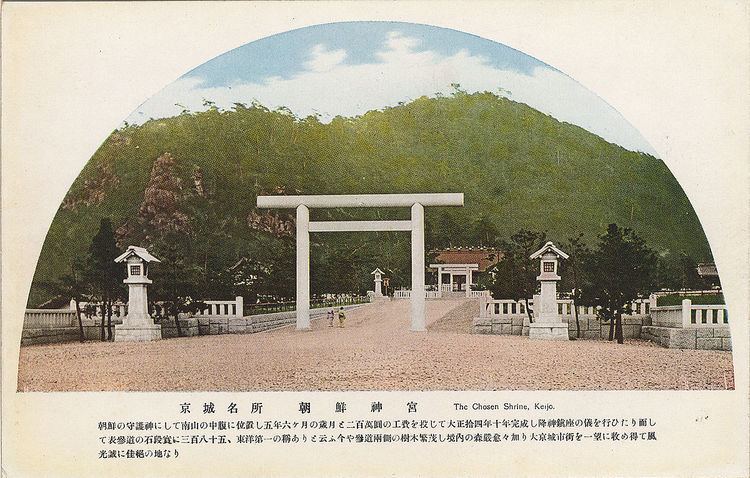 | ||
The origins of Shinto in Korea are primarily a result of Japan's incursions since an unbalanced treaty in 1876. Shinto's rise in Korea is directly associated with the Japanese government's purely ideological use of the traditional folk practices of Japan, later described as "State Shinto." As Japan expanded its control of Korea, it also expanded the number of shrines, with the aim of one national shrine in each province. By 1945, attendance at shrines was in many cases compulsory.
Contents
Introduction of Shinto
Japan's Meiji restoration had been actively rejecting any relationship between Shinto, the folk tradition of Japan, and religious belief. Imperial Japan interpreted Shinto as a "suprareligious" institution based on a set of traditions, rather than moral instructions. As such, requirements to participate in Shinto ceremonies were not deemed to be a violation of the Meiji-era's freedom of religion doctrine. This was the position of the state, later described as "State Shinto," and not necessarily followed by priests or practitioners of Shinto.
Introduction of shrines
The earliest Shinto shrine in Korea is believed to be Kotohira shrine (金刀比羅神社), later Ryūtōsan shrine (龍頭山神社), built in 1678, built by workers of the local Japan House trade office.
In 1876, the Japan-Korea Treaty of Amity introduced Japanese settlers, and Shinto proselytizers, to Incheon, Pusan, and Wonsan. As Japanese traders arrived in these ports, they brought Shinto practices with them. For example, Genzan shrine (元山神社), in Wonsan, was constructed in 1882, and was later elevated to National Shrine status by the Japanese in 1936. By 1911, Daijingu (大神宮), Sugawara Tenmangu (菅原神社), and Konpira (金刀比羅神社) shrines had been established, ostensibly for the practice of Japanese nationals living there. Other active groups included Konkokyo (金光教), Tenrikyo (天理教), Ontakekyo (御岳教), and Shinrikyo (神理教).
After the Japan-Korea treaty of 1910, Korea was fully under Japanese rule. In turn, the Governor-General responsible for managing Korea for Imperial Japan was empowered to expand the use of shrines there. A year later, a police report on shrine activities in Korea stated that "shrines are established for the purpose of the protection of local areas, and are deeply revered among many residents. Shrines are managed along with other civic groups by the local association of Japanese residents."
In 1913, to mark the anniversary of the occupation, members of the Korean royal family presented an offering to Amaterasu at a Shinto shrine in Seoul, signaling their subordination to the Japanese government. Meanwhile, Japanese expatriates at this time were protective of Japanese customs, and reluctant to engage or inform Koreans about shrine practices, despite government orders to promote them, and the Japanese government struggled to incorporate Korean nationals into leadership roles at the shrines.
Chosen shrine, in Seoul, was built in 1920 and was named an Imperial Shrine in 1925 (a few months ahead of completion). It was the first Korean shrine to be funded by the state, and was established as the first in a series of national shrines to be built in each Korean province. By the 1930s, it was the Korean Governor-General's policy to build a Shinto shrine in every village in Korea, and the total reached 995 by the end of the Japanese occupation in 1945. This was 57 percent of all shrines Japan built outside of Japan during the war. These shrines were more aggressive in their outreach to locals than the expatriate-led shrines had been before.
Compulsory attendance
In 1925, primary school students and staff were required to attend local shrines as part of a "Imperial subject-making" initiative, kōminka seisaku. In 1936, shrine worship was made compulsory for university students as well. Schools refusing to participate in these trips could be closed. Under the National Mobilization law of 1938, laws requiring Christian schools to visit shrines were expanded to include all Christians. That September, members of a Presbyterian church in Korea were forced to visit a shrine by soldiers with bayonets.
Integration with Korean tradition
Japanese Imperial scholars such as Ryuzo Torii and Ogasawara Shōzō’ advocated the position that Korean and Japanese folk traditions shared a common, shamanic link, which bolstered Imperial Japanese claims about the legitimacy of the Korean occupation. This argument lead them to encourage fusing the worship of the Meiji Emperor with Tan'gun, a legendary founder of Korea. A Korean scholar, Choe Nam-seon, challenged this belief by asserting that Tan'gun was the origination point of Shinto, urging a reconsideration of Shinto as one, localized aspect of a broader shamanistic tradition in Asia. Nam-seon was eventually pressured to promote the idea that Shinto was the key manifestation of this tradition, and that all Asian folk traditions were essentially Shinto in other forms.
Other intellectuals at the time emphasized what came to be called "the Inheritance Myth." This argued that Tan'gun, the "Kami" of Korea, had passed control of Korean land to the Imperial family, owing to the families deep ties to the Shinto sun goddess, Amaterasu Okami. However, the State apparatus declined to fully incorporate Tan'gun into Chosen Shrine, which housed only the kami of Amaterasu Ōmikami and Emperor Meiji.
Post-war
With Japan's surrender and the liberation of Korea, Shinto shrines were the focus of contempt in the streets of Seoul, with papers posted on walls urging citizens to burn them down. As Koreans began pilfering smaller shrines around the country, Shinto priests at Chosen shrine withdrew Japanese relics, and soon created a plan to destroy the Korean National Shrine of their own accord. The site was initially replaced with a Presbyterian Theological Seminary.
